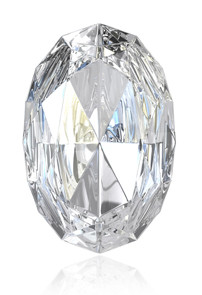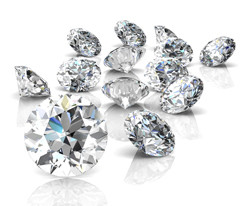History of Diamonds
The name diamond is derived from the ancient Greek "adamao": "I tame" or "I subdue." The adjective "adamas" was used to describe the hardest substance known, and eventually became synonymous with diamond.
Diamonds are thought to have been first recognized and mined in India, where significant alluvial deposits of the stone could be found many centuries ago along the rivers Penner, Krishna and Godavari. Diamonds have been known in India for at least 3,000 years but most likely 6,000 years. Diamonds have been treasured as gemstones since their use as religious icons in ancient India. Their usage in engraving tools also dates to early human history.

Diamonds were known in ancient Greece and the Roman Empire. Consider the ancient Greeks and Romans who believed diamonds were tears of the Gods and splinters from falling stars. Not only was it believed that diamonds could bring luck and success, but also that they could counter the effects of astrological events. There were many that wore diamonds as charms believing in their ability to heighten sexual prowess and attract others. Plato even wrote about diamonds as living beings, embodying celestial spirits.
Small numbers of diamonds began appearing in European regalia and jewelry in the 13th century, set as accent points among pearls in wrought gold. By the 16th century the diamonds became larger and more prominent, in response to the development of diamond faceting, which enhances their brilliance and fire. Diamonds came to dominate small jewels during the 17th century and large ones by the 18th century.
into spectral colors is the primary gemological characteristic of gem diamonds. In the 20th century, experts in gemology have developed methods of grading diamonds and other gemstones based on the characteristics most important to their value as a gem. Four characteristics, known informally as the four Cs, are now commonly used as the basic descriptors of diamonds: these are carat, cut, color, and clarity. A large, flawless diamond is known as a paragon.

In the 13th Century, Louis IX of France established a law reserving diamonds for the king. This bespeaks the rarity of diamonds and the value conferred on them at that time. Within 100 years diamonds appeared in royal jewelry of both men and women, then among the greater European aristocracy, with the wealthy merchant class showing the occasional diamond by the 17th century. As more diamonds reached Europe, demand for them increased. The earliest diamond-cutting industry is believed to have been in Venice, a trade capital, starting sometime after 1330. Diamond cutting may have arrived in Paris by the late 14th century. By the late 14th century, the diamond trade route went to Bruges and Paris,and later to Antwerp.
By 1499, the Portuguese navigator Vasco da Gama discovered the sea route to the Orient around the Cape of Good Hope, providing Europeans an end-run around the Arabic impediment to the trade of diamonds coming from India.
In 1772, Antoine Lavoisier used a lens to concentrate the rays of the sun on a diamond in an atmosphere of oxygen, and showed that the only product of the combustion was carbon dioxide, proving that diamond is composed of carbon. Later in 1797, Smithson Tennant repeated and expanded that experiment. By demonstrating that burning diamond and graphite releases the same amount of gas he established the chemical equivalence of these substance.
The popularity of diamonds has risen since the 19th century because of increased supply, improved cutting and polishing techniques, growth in the world economy, and innovative and successful advertising campaigns.
Modern diamond mining as we know it today began in South Africa in the late 19th century. The top seven diamond-producing countries, accounting for 80 percent of the world’s rough diamond supply, are Botswana, Russia, South Africa, Angola, Namibia, Australia and the Democratic Republic of the Congo.
The most familiar use of diamonds today is as gemstones used for adornment, a use which dates back into antiquity. The dispersion of white light

Contact us on:

